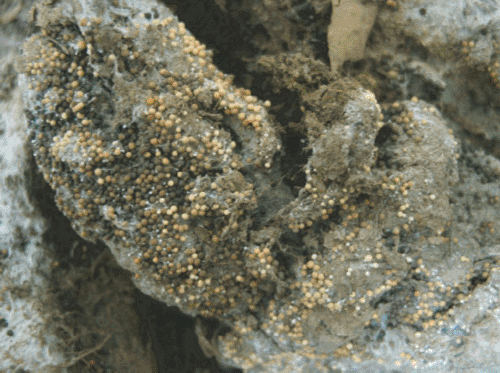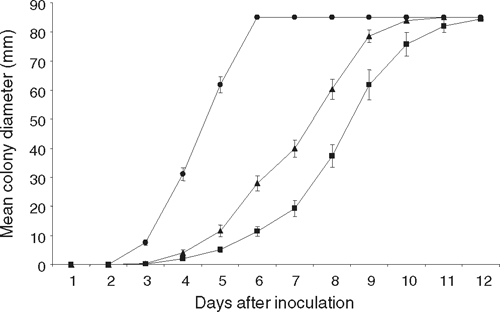An in vitro study into the effect of glyphosate on Sclerotium rolfsii
D. Westerhuis A , L. L. Vawdrey A C and R. Piper BA Horticulture, Department of Primary Industries, Centre for Wet Tropics Agriculture, South Johnstone, Qld 4859 Australia.
B Scientific Advisory Services, Tully, Qld 4854 Australia.
C Corresponding author. Email: lynton.vawdrey@dpi.qld.gov.au
Australasian Plant Disease Notes 2(1) 23-24 https://doi.org/10.1071/DN07010
Submitted: 6 December 2006 Accepted: 27 January 2007 Published: 13 February 2007
Abstract
The emergence of banana plants from planted corm pieces is known to be adversely affected by Sclerotium rolfsii, a fungal pathogen that is common in soil and plant debris. Glyphosate at 3.6 g/L reduced the radial growth of S. rolfsii in pure culture compared with benomyl at 0.5 g/L and an untreated control. This result supports anecdotal observations that glyphosate sprays can inhibit the growth of S. rolfsii affecting banana material in the field.
Additional keywords: herbicides, soilborne fungi.
Glyphosate is a broad-spectrum herbicide and potent inhibitor of 5-enolpyruvyl shikamate 3-phosphate synthase (EPSPS), a key enzyme in the synthesis of aromatic amino acids present in plants, fungi and bacteria (Steinrücken and Amrhein 1980). Consequently, fungi and bacteria with glyphosate-sensitive EPSPS may be susceptible to the action of glyphosate. Wardle and Parkinson (1990) in their study of glyphosate on soil microflora observed that glyphosate reduced the radial growth of Fusarium oxysporum grown in vitro while Descalzo et al. (1998) reported that glyphosate can cause temporary increases in both Pythium populations and the damping-off potential of soils.
In 2005, a banana grower in the Tully area of far north Queensland observed that pieces of banana corm material brought to the surface during cultivation were partly covered with fans of coarse white fungal mycelium and 1–2-mm light brown globose sclerotia (Fig. 1). Based on the morphological features, the causal fungus was identified as Sclerotium rolfsii Sacc. (L. Vawdrey, pers. comm.), a common soilborne plant pathogen known to persist on crop residues (Punja 1985). The grower also noted that rotting corm pieces inadvertently sprayed with glyphosate as part of his weed management program had little mycelial growth and fewer sclerotes than corms not sprayed with the herbicide. The grower questioned whether glyphosate sprays used to eradicate banana plants before fallowing might also provide control of S. rolfsii. This paper reports on a study into the effect of glyphosate on the radial growth of S. rolfsii in pure culture.

|
Samples of disease-affected corm material were received at the plant pathology laboratory at the Centre for Wet Tropics Agriculture in north Queensland. Sections of diseased corm were surface sterilised in 3% NaOCl for 1 min, blotted dry with sterile paper then transferred to 2% potato dextrose agar (PDA) plus streptomycin sulfate (PDA + S) culture medium and placed in an incubator in the dark at 27°C. After 6 days, typical sclerotia had formed in culture and colonies of S. rolfsii with clamp connections at septae were observed microscopically. Axenic cultures of S. rolfsii with sclerotia were maintained on PDA + S culture medium.
Growth of S. rolfsii was tested on culture plates of PDA + S medium amended with glyphosate as Glyphosate 360 at the commercial rate of application of 3.6 g a.i./L. Comparison was made with PDA + S medium amended with benomyl as Benlate at the commercial rate of 0.5 g a.i./L (Infopest 2003) and an untreated control. Each amended medium was prepared by adding, under aseptic conditions, the appropriate concentration of filter-sterilised chemical to molten PDA + S agar. A single S. rolfsii sclerotium was then placed in the centre of freshly poured plates of each of the amended culture media. Sixteen replicate plates were used per treatment. Diameters of developing colonies were measured daily and the mean calculated over 11 days or until the colony reached the periphery of the Petri dish. Results were expressed as the mean colony diameter and the standard error of the mean.
Colony growth of S. rolfsii on unamended PDA + S commenced 3 days after inoculation and had reached the periphery of the Petri dish 6 days after inoculation (Fig. 2). Colony growth on glyphosate- and benomyl-amended media commenced 4 days after inoculation and had reached the periphery of the Petri dish 11–12 days after inoculation. Both amended media reduced the radial growth of S. rolfsii compared with the unamended medium, with the glyphosate-amended medium having the greater inhibitory effect. These results support the observations of the banana grower that glyphosate sprays might inhibit the growth of S. rolfsii affecting banana material in the field.

|
Descalzo RC,
Punja ZK,
Levesque CA, Rahe JE
(1998) Glyphosate treatment of bean seedlings causes short-term increases in Pythium populations and damping off potential in soils. Applied Soil Ecology 8, 25–33.
| Crossref | GoogleScholarGoogle Scholar |

Punja ZK
(1985) The biology, ecology and control of Sclerotium rolfsii. Annual Review of Phytopathology 23, 97–127.

Steinrücken HC, Amrhein N
(1980) The herbicide glyphosate is a potent inhibitor of 5-phosphate synthase. Biochemical and Biophysical Research Communications 94, 1207–1212.
| Crossref | GoogleScholarGoogle Scholar | PubMed |

Wardle DA, Parkinson D
(1990) Influence of the herbicide glyphosate on soil microbial community structure. Plant and Soil 122, 29–37.



